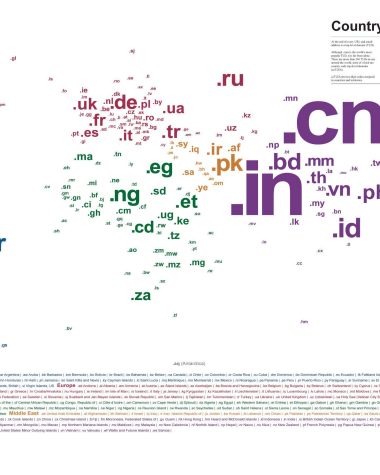In the ever-expanding universe of the Internet, website addresses, or URLs, serve as the coordinates that guide users to their desired online destinations. At the heart of these coordinates is an essential component known as the top-level domain (TLD). This article aims to delve deeply into what a top-level domain is, the various types of TLDs, and the significant role they play in the Internet’s overall structure and operations.
Understanding Domains and the Domain Name System (DNS)
To comprehend what a TLD is, one must first grasp the fundamental concept of a domain and the Domain Name System (DNS). In essence, a domain name is a string of text that replaces IP addresses, which are typically complex sequences of numbers that computers use to communicate with each other.
The DNS, a hierarchical and decentralized naming system, enables users to access websites using these human-friendly domain names instead of the less memorable numerical IP addresses.
What is a Top-Level Domain (TLD)?
A TLD is the last part of a domain name, typically appearing after the final dot. For example, in www.google.com, ‘.com’ is the TLD. TLDs are an integral part of the Internet’s hierarchical domain name structure, occupying the highest position in the DNS.
The primary function of a TLD is to categorize websites broadly, often based on the nature of the organization or geographical location. They give internet users a basic idea about the website’s purpose or where it originates, even before they visit it.
Types of Top-Level Domains
TLDs come in various types, each serving a distinct function. Understanding these differences is crucial in navigating the digital landscape, whether you’re a casual surfer or a website developer.
Generic Top-Level Domains (gTLDs)
This category is the most prevalent type of TLD, with the familiar ‘.com’ leading the pack. Other examples include ‘.net’ for network sites, ‘.org’ for organizations, ‘.gov’ for U.S. government entities, and ‘.edu’ for educational institutions. In recent years, the Internet Corporation for Assigned Names and Numbers (ICANN) expanded the gTLDs list to include a more diverse array, such as ‘.music’, ‘.movie’, and ‘.shop’, allowing organizations to align their websites more closely with their brand or industry.
Sponsored Top-Level Domains (sTLDs)
These are a subset of gTLDs that are sponsored by agencies or organizations that enforce eligibility requirements for using the domain. Examples include ‘.aero’ for the aviation community, ‘.museum’ for museums, and ‘.coop’ for cooperatives.
Country Code Top-Level Domains (ccTLDs)
ccTLDs denote specific geographic locations. Each country has a unique two-letter TLD, such as ‘.uk’ for the United Kingdom, ‘.ca’ for Canada, ‘.au’ for Australia, and ‘.in’ for India. These domains are beneficial for local businesses or organizations that mainly serve users in a particular country or region.
Infrastructure Top-Level Domain
There is only one infrastructure TLD, and that is ‘.arpa’. Managed by the Internet Architecture Board (IAB), it’s primarily used for technical infrastructure purposes.
Internationalized Top-Level Domains (IDNs)
IDNs are TLDs in non-Latin scripts (e.g., Arabic, Chinese, Cyrillic). This type of TLD helps increase the accessibility of the internet to users worldwide, as it allows domains to be registered in various languages and scripts.
Significance of Choosing the Right TLD
The selection of a TLD is crucial for businesses and organizations building an online presence. The right TLD can provide the following benefits:
Relevance and Categorization: TLDs can communicate essential information about a website, such as its purpose or geographic origin. This could help in search engine optimization (SEO) and make your website more discoverable to relevant audiences.
Branding: A well-chosen TLD can enhance brand recognition and credibility. It can also express a brand’s values, industry, or creativity.
Availability: Given the saturation of certain TLDs, like ‘.com’, finding an available domain name can be challenging. Exploring less crowded TLDs may yield more options and creative possibilities.
The Role of ICANN in TLD Management
The Internet Corporation for Assigned Names and Numbers (ICANN) plays a crucial role in the management and regulation of TLDs. As an internationally organized, non-profit corporation, ICANN coordinates unique identifiers across the world, ensuring the Internet’s stable and secure operation.
ICANN has the authority to create new TLDs, manage the root zone (the highest level of the domain name system structure), and accredit domain name registrars. Its mission is to ensure a globally unified, scalable Internet that is accessible to all users around the world.
Purchasing and Registering a TLD
To purchase and register a TLD, one must go through a domain name registrar, an organization or commercial entity accredited by ICANN or a national ccTLD authority. This process typically involves searching for an available domain name, choosing your preferred TLD, and purchasing the domain for a period of time, often between one and ten years.
During this process, it’s important to consider the implications of your chosen TLD. Different TLDs may have varying costs, renewal policies, and registration requirements. Also, while some TLDs are open to the general public, others, like ‘.gov’ and ‘.edu’, have specific eligibility requirements.
The Future of TLDs
As the Internet continues to evolve, the landscape of TLDs will likely change and adapt. There is potential for more TLD options as industries and trends evolve, and as the push for a more multilingual Internet continues.
Furthermore, as new technologies like blockchain develop, new types of TLDs may emerge. For instance, decentralized domain systems like Ethereum Name Service (ENS) are already introducing ‘.eth’ domains.
While TLDs may seem a small part of the Internet’s architecture, they are fundamental to its operation, serving as both functional identifiers and cultural signifiers within the digital ecosystem. As such, understanding TLDs, their role, and their potential is crucial for anyone navigating this increasingly interconnected world.
To conclude, a top-level domain (TLD) is an integral component of every website address, providing essential information about the site’s nature or geographic origin. Through their unique categorization capabilities, TLDs play a significant role in the DNS, enhancing the accessibility and navigability of the Internet. As the digital landscape continues to evolve, so too will the world of TLDs, reflecting changes in technology, language, and culture, and shaping the future of our online universe.
Security and TLDs
As important as TLDs are for defining the digital landscape, their impact extends to the realm of cybersecurity as well. Cybercriminals often exploit the significance of TLDs to mislead users into visiting harmful websites, a practice known as cybersquatting or domain squatting.
These malicious actors register domain names similar to popular brands or organizations, usually with a slight misspelling or a different TLD. Unwary users may mistake these fraudulent websites for legitimate ones, potentially exposing their personal information or falling prey to phishing attacks. Hence, awareness about TLDs can aid in safer navigation of the Internet.
TLDs and SEO
In the realm of SEO, there’s been a longstanding debate about the impact of TLDs on website rankings. Earlier, it was widely believed that .com domains were more SEO-friendly, primarily because of their familiarity and prevalence. However, Google has repeatedly stated that, all other things being equal, their search algorithm does not favor one TLD over another.
However, where TLDs can indirectly impact SEO is through user perception and behavior. Internet users are generally more familiar with .com domains and may perceive them as more trustworthy, which can lead to higher click-through rates.
Also, ccTLDs can help businesses rank higher in location-specific search results by signaling to search engines that the content is specifically relevant to users in that particular country.
Legacy TLDs and the Modern Internet
One interesting aspect of TLDs is the survival and evolution of so-called legacy TLDs such as .com, .net, and .org. These TLDs, established in the 1980s, have withstood the test of time and technological advancement and remain the most popular TLDs to this day.
Part of their longevity can be attributed to their first-mover advantage. As some of the first TLDs on the scene, they achieved wide recognition and acceptance early on. Over the years, this recognition has snowballed, solidifying their dominance. Today, despite the introduction of over a thousand new TLDs, the legacy TLDs hold their ground as trusted, reliable, and recognizable online identities.
Wrapping Up
The landscape of TLDs is expansive, diverse, and ever-evolving, much like the Internet itself. From the familiar .com to the localized ccTLDs, and from the specialized sTLDs to the burgeoning world of IDNs, TLDs paint a fascinating picture of the Internet’s composition, culture, and change. They exemplify how the Internet is a dynamic blend of technology and human factors, each influencing and shaping the other.
From businesses looking to establish an online presence, organizations aiming to build credibility, to everyday users navigating the vast digital landscape, an understanding of TLDs is crucial. They are not just the concluding segment of a web address; they are pivotal elements in how we understand, navigate, secure, and experience the digital world. As the Internet continues its ceaseless expansion and evolution, the story of TLDs will continue to unfold, revealing new chapters in this remarkable saga of human innovation.
The Economy of TLDs
As with many aspects of the Internet, there is a commercial dimension to TLDs. Many businesses have found value in investing in premium domain names, particularly .com names, due to their widespread recognition and perceived credibility. Acquiring a simple, memorable domain name with a popular TLD can often involve considerable expenditure.
The value of a domain name can be influenced by several factors: the simplicity and relevance of the name, the popularity and credibility of the TLD, and sometimes even the potential for future demand. Auctions for premium domain names have fetched staggering prices, with names like Insurance.com and VacationRentals.com reportedly selling for over $30 million.
Yet, it’s not just about the .com domain. The advent of new gTLDs has also seen lucrative domain name sales. For example, the sale of ‘home.loans’ reportedly commanded a seven-figure price tag, demonstrating that newer TLDs also hold significant commercial potential.
Controversies and Disputes Over TLDs
The world of TLDs has had its share of controversies and disputes. One recurring issue involves trademark infringement, where a domain name is seen to violate a registered trademark. The Uniform Domain-Name Dispute-Resolution Policy (UDRP) is a process established by ICANN for the resolution of such disputes.
Another contentious issue involves the distribution and management of new gTLDs. There have been disagreements over who should have the right to manage potentially lucrative TLDs, leading to competitive bidding wars. Questions of fairness, access, and control over these digital resources continue to spark debate within the Internet community.
Conclusion: TLDs – An Integral Part of the Internet Ecosystem
To sum it up, TLDs are much more than mere website suffixes. They play a fundamental role in how the Internet functions, impacting everything from website identity, user behavior, SEO strategies, digital marketing, cybersecurity, to shaping the Internet economy. As the digital world continues to evolve, so will the landscape of TLDs, likely in ways we can’t yet foresee.
Just as importantly, they tell a story of the Internet itself – a story of technological innovation, commercial opportunity, human cooperation and competition, of a world growing ever more interconnected. As users, businesses, and developers, understanding TLDs allows us to better navigate this digital landscape and harness the potential it holds.
In a rapidly digitizing world, top-level domains (TLDs) will continue to serve as pivotal signposts in our online journeys. Their influence extends far beyond their simplistic representation in a URL; they hold power in shaping perceptions, driving user behavior, and defining the digital identity of millions of web entities worldwide. So, whether you are a casual internet user, a prospective website owner, or an SEO enthusiast, understanding TLDs is no longer a niche necessity but a digital literacy essential in the 21st century.










